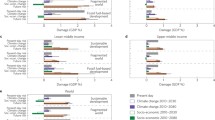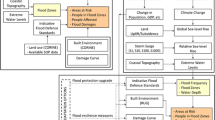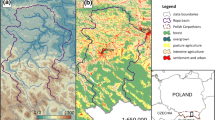Abstract
Floods are among the most frequent and costliest natural hazards. Fluvial flood losses are expected to increase in the future, driven by population and economic growth in flood-prone areas, and exacerbated in many regions by effects of climate change on the hydrological cycle. Yet, studies assessing direct and indirect economic impacts of fluvial flooding in combination with climate change and socio-economic projections at a country level are rare. This study presents an integrated flood risk analysis framework to calculate total (direct and indirect) economic damages, with and without socio-economic development, under a range of warming levels from < 1.5 to 4 °C in Brazil, China, India, Egypt, Ethiopia, and Ghana. Direct damages are estimated by linking spatially explicit daily flood hazard data from the Catchment-based Macro-scale Floodplain (CaMa-Flood) model with country- and sector-specific depth-damage functions. These values input into an economic Input-Output model for the estimation of indirect losses. The study highlights that total fluvial flood losses are largest in China and India when expressed in absolute terms. When expressed as a share of national GDP, Egypt faces the largest total losses under both the climate change and climate change plus socio-economic development experiments. The magnitude of indirect losses also increased significantly when socio-economic development was modelled. The study highlights the importance of including socio-economic development when estimating direct and indirect flood losses, as well as the role of recovery dynamics, essential to provide a more comprehensive picture of potential losses that will be important for decision makers.





Similar content being viewed by others
Data availability
Data and models used are outlined in the text and listed in full in the references.
Code availability
Not applicable.
Notes
In this paper, we use bold capital letters to represent matrices (e.g. I and A), italic bold lowercase letters for vectors (e.g. x), and italic lowercase letters for scalars (e.g. n). Vectors are column vectors by default, and the transposition is denoted by an apostrophe (e.g. x'). The conversion from a vector to a diagonal matrix is expressed as italic bold lowercase letters with a circumflex (e.g. \( \hat{\boldsymbol{\alpha}} \)).
Although damage to residential capital can have indirect effects on the production process as its recovery results in a non-negligible part of the total reconstruction demand, competing with industrial capital for reconstruction resources.
References
Alfieri L, Feyen L, Dottori F et al (2015) Ensemble flood risk assessment in Europe under high end climate scenarios. Glob Environ Change 35:199–212. https://doi.org/10.1016/j.gloenvcha.2015.09.004
Alfieri L, Bisselink B, Dottori F et al (2017) Global projections of river flood risk in a warmer world. Earth’s Future 5:171–182. https://doi.org/10.1002/2016EF000485
Aliboni R (2012) Egypt’s economic potential (RLE Egypt). Routledge, London & New York
Arnell NW, Gosling SN (2016) The impacts of climate change on river flood risk at the global scale. Clim Chang 134:387–401. https://doi.org/10.1007/s10584-014-1084-5
Arnell NW, Lloyd-Hughes B (2014) The global-scale impacts of climate change on water resources and flooding under new climate and socio-economic scenarios. Clim Chang 122:127–140. https://doi.org/10.1007/s10584-013-0948-4
Carrera L, Standardi G, Bosello F et al (2015) Assessing direct and indirect economic impacts of a flood event through the integration of spatial and computable general equilibrium modelling. Environ Model Softw 63:109–122. https://doi.org/10.1016/j.envsoft.2014.09.016
Dottori F, Szewczyk W, Ciscar J-C et al (2018) Increased human and economic losses from river flooding with anthropogenic warming. Nat Clim Chang 8:781–786. https://doi.org/10.1038/s41558-018-0257-z
EM-DAT (2020) EM-DAT: the emergency events database - Université catholique de Louvain (UCL) - CRED, D. Guha-Sapir - www.emdat.be, Brussels, Belgium. Accessed 7 Feb 2020
ESA (2017) Land cover CCI product user guide version 2. Technical Report, UCL-Geomatics, Belgium
Galbusera L, Giannopoulos G (2018) On input-output economic models in disaster impact assessment. Int J Disast Risk Re 30:186–198. https://doi.org/10.1016/j.ijdrr.2018.04.030
Gütschow J, Jeffery ML, Schaeffer M et al (2018) Extending near-term emissions scenarios to assess warming implications of Paris Agreement NDCs. Earth’s Future 6:1242–1259. https://doi.org/10.1002/2017EF000781
Hallegatte S (2008) An adaptive regional input-output model and its application to the assessment of the economic cost of Katrina. Risk Anal 28:779–799. https://doi.org/10.1111/j.1539-6924.2008.01046.x
Hallegatte S, Hourcade J-C, Dumas P (2007) Why economic dynamics matter in assessing climate change damages: illustration on extreme events. Ecol Econ 62:330–340. https://doi.org/10.1016/j.ecolecon.2006.06.006
He Y, Manful D, Warren F et al (2020) Quantification of impacts between 1.5°C and 4°C of global warming on flooding risks in six countries. Climatic change this special issue In review
Hirabayashi Y, Kanae S (2009) First estimate of the future global population at risk of flooding. Hydrol Res Lett 3:6–9. https://doi.org/10.3178/hrl.3.6
Hirabayashi Y, Mahendran R, Koirala S et al (2013) Global flood risk under climate change. Nat Clim Chang 3:816–821. https://doi.org/10.1038/nclimate1911
Huizinga J, de Moel H, Szewczyk W (2017) Global flood depth-damage functions. Methodology and the database with guidelines. Publications Office of the European Union, Luxembourg
IMF (2015) Investment and capital stock dataset. International Monetary Fund. https://data.imf.org/?sk=1CE8A55F-CFA7-4BC0-BCE2-256EE65AC0E4
Jiménez Cisneros BE, Oki T, Arnell NW et al (2014) Freshwater resources. In: Field CB, Barros VR, Dokken DJ et al (eds) Climate change 2014: impacts, adaptation, and vulnerability. Part A: Global and Sectoral Aspects. Contribution of Working Group II to the Fifth Assessment Report of the Intergovernmental Panel on Climate Change. Cambridge University Press, Cambridge, United Kingdom and New York, NY, USA, pp 229–269
Jongman B, Ward PJ, Aerts JCJH (2012) Global exposure to river and coastal flooding: long term trends and changes. Glob Environ Change 22:823–835. https://doi.org/10.1016/j.gloenvcha.2012.07.004
Jongman B, Winsemius HC, Aerts JCJH et al (2015) Declining vulnerability to river floods and the global benefits of adaptation. Proc Natl Acad Sci U S A 112:E2271–E2280. https://doi.org/10.1073/pnas.1414439112
Kajitani Y, Tatano H (2017) Applicability of a spatial computable general equilibrium model to assess the short-term economic impact of natural disasters. Econ Syst Res 30:289–312. https://doi.org/10.1080/09535314.2017.1369010
Koks EE, Thissen M (2016) A multiregional impact assessment model for disaster analysis. Econ Syst Res 28:429–449. https://doi.org/10.1080/09535314.2016.1232701
Koks EE, Bočkarjova M, de Moel H et al (2015) Integrated direct and indirect flood risk modeling: development and sensitivity analysis. Risk Anal 35:882–900. https://doi.org/10.1111/risa.12300
Koks EE, Carrera L, Jonkeren O et al (2016) Regional disaster impact analysis: comparing input–output and computable general equilibrium models. Nat Hazards Earth Syst Sci 16:1911–1924. https://doi.org/10.5194/nhess-16-1911-2016
Koks EE, Thissen M, Alfieri L et al (2019) The macroeconomic impacts of future river flooding in Europe. Environ Res Lett 14:084042. https://doi.org/10.1088/1748-9326/ab3306
Kundzewicz ZW, Kanae S, Seneviratne SI et al (2014) Flood risk and climate change: global and regional perspectives. Hydrolog Sci J 59:1–28. https://doi.org/10.1080/02626667.2013.857411
Mendoza-Tinoco D, Guan D, Zeng Z et al (2017) Flood footprint of the 2007 floods in the UK: the case of the Yorkshire and the Humber region. J Clean Prod 168:655–667. https://doi.org/10.1016/j.jclepro.2017.09.016
Mendoza-Tinoco D, Hu Y, Zeng Z et al (2020) Flood footprint assessment: a multiregional case of 2009 central European floods. Risk Anal 40:1612–1631. https://doi.org/10.1111/risa.13497
Meyer V, Becker N, Markantonis V et al (2013) Review article: assessing the costs of natural hazards – state of the art and knowledge gaps. Nat Hazards Earth Syst Sci 13:1351–1373. https://doi.org/10.5194/nhess-13-1351-2013
Mokrech M, Kebede AS, Nicholls RJ et al (2015) An integrated approach for assessing flood impacts due to future climate and socio-economic conditions and the scope of adaptation in Europe. Clim Chang 128:245–260. https://doi.org/10.1007/s10584-014-1298-6
Muis S, Güneralp B, Jongman B et al (2015) Flood risk and adaptation strategies under climate change and urban expansion: a probabilistic analysis using global data. Sci Total Environ 538:445–457. https://doi.org/10.1016/j.scitotenv.2015.08.068
Okuyama Y, Santos JR (2014) Disaster impact and input-output analysis. Econ Syst Res 26:1–12. https://doi.org/10.1080/09535314.2013.871505
Riahi K, van Vuuren DP, Kriegler E et al (2017) The shared socioeconomic pathways and their energy, land use, and greenhouse gas emissions implications: an overview. Glob Environ Change 42:153–168. https://doi.org/10.1016/j.gloenvcha.2016.05.009
Rojas R, Feyen L, Watkiss P (2013) Climate change and river floods in the European Union: socio-economic consequences and the costs and benefits of adaptation. Glob Environ Change 23:1737–1751. https://doi.org/10.1016/j.gloenvcha.2013.08.006
Rose A, Liao S-Y (2005) Modeling regional economic resilience to disasters: a computable general equilibrium analysis of water service disruptions. J Regional Sci 45:75–112. https://doi.org/10.1111/j.0022-4146.2005.00365.x
Scussolini P, Aerts JCJH, Jongman B et al (2016) FLOPROS: an evolving global database of flood protection standards. Nat Hazards Earth Syst Sci 16:1049–1061. https://doi.org/10.5194/nhess-16-1049-2016
Sieg T, Schinko T, Vogel K et al (2019) Integrated assessment of short-term direct and indirect economic flood impacts including uncertainty quantification. PLoS One 14:e0212932. https://doi.org/10.1371/journal.pone.0212932
Sperna Weiland FC, van Beek LPH, Kwadijk JCJ et al (2012) Global patterns of change in discharge regimes for 2100. Hydrol Earth Syst Sci 16:1047–1062. https://doi.org/10.5194/hess-16-1047-2012
Tanoue M, Hirabayashi Y, Ikeuchi H (2016) Global-scale river flood vulnerability in the last 50 years. Sci Rep 6:36021. https://doi.org/10.1038/srep36021
UNDRR (2015) Sendai framework for disaster risk reduction 2015–2030. UNISDR, Geneva
van Vuuren DP, Stehfest E, Gernaat DEHJ et al (2017) Energy, land-use and greenhouse gas emissions trajectories under a green growth paradigm. Glob Environ Change 42:237–250. https://doi.org/10.1016/j.gloenvcha.2016.05.008
Ward PJ, Jongman B, Sperna Weiland F et al (2013) Assessing flood risk at the global scale: model setup, results, and sensitivity. Environ Res Lett 8:044019. https://doi.org/10.1088/1748-9326/8/4/044019
Ward PJ, Jongman B, Aerts JCJH et al (2017) A global framework for future costs and benefits of river-flood protection in urban areas. Nat Clim Chang 7:642–646. https://doi.org/10.1038/nclimate3350
Warren R, Hope C, Gernaat DEHJ et al (2020) Global and regional aggregate economic damages associated with global warming of 1.5 to 4°C above pre-industrial levels. Climatic change this special issue In review
Willner SN, Otto C, Levermann A (2018) Global economic response to river floods. Nat Clim Chang 8:594–598. https://doi.org/10.1038/s41558-018-0173-2
Winsemius HC, van Beek LPH, Jongman B et al (2013) A framework for global river flood risk assessments. Hydrol Earth Syst Sci 17:1871–1892. https://doi.org/10.5194/hess-17-1871-2013
Winsemius HC, Aerts JCJH, van Beek LPH et al (2016) Global drivers of future river flood risk. Nat Clim Chang 6:381–385. https://doi.org/10.1038/nclimate2893
World Bank (2019) World development indicators. The World Bank Group, Washington, D.C.
Funding
K.J., Y.H., N.F., R.W., and R.J. acknowledge support from the UK government, Development for Business, Energy and Industrial Strategy. D.G. acknowledges support from the National Natural Science Foundation of China (41921005, 72091514). L.Y. acknowlwdges support from the National Key R &D Program of China (2019YFC0810705, 2018YFC0807000) and the National Natural Science Foundation of China (71771113).
Author information
Authors and Affiliations
Contributions
Zhiqiang Yin and Dabo Guan designed the study. Zhiqiang Yin and Yixin Hu performed the analysis. Zhiqiang Yin carried out the direct damage modelling, and Yixin Hu carried out the indirect damage modelling. Zhiqiang Yin, Yixin Hu and Katie Jenkins interpreted the results and prepared the manuscript. Katie Jenkins prepared the figures and Supplementary Material. Yi He provided the flood hazard data. Nicole Forstenhäusler prepared the land cover data. Lili Yang contributed to the input-output modelling. Rhosanna Jenkins contributed to the literature review in Supplementary Material. Rachel Warren and Dabo Guan coordinated and supervised the project and reviewed the manuscript.
Corresponding author
Ethics declarations
Conflict of interest
The authors declare no competing interests.
Additional information
Publisher’s note
Springer Nature remains neutral with regard to jurisdictional claims in published maps and institutional affiliations.
This article is part of the topical collection Accrual of Climate Change Risk in Six Vulnerable Countries, edited by Daniela Jacob and Tania Guillén Bolaños
Supplementary Information
ESM 1
(DOCX 4.12 mb)
Rights and permissions
About this article
Cite this article
Yin, Z., Hu, Y., Jenkins, K. et al. Assessing the economic impacts of future fluvial flooding in six countries under climate change and socio-economic development. Climatic Change 166, 38 (2021). https://doi.org/10.1007/s10584-021-03059-3
Received:
Accepted:
Published:
DOI: https://doi.org/10.1007/s10584-021-03059-3




